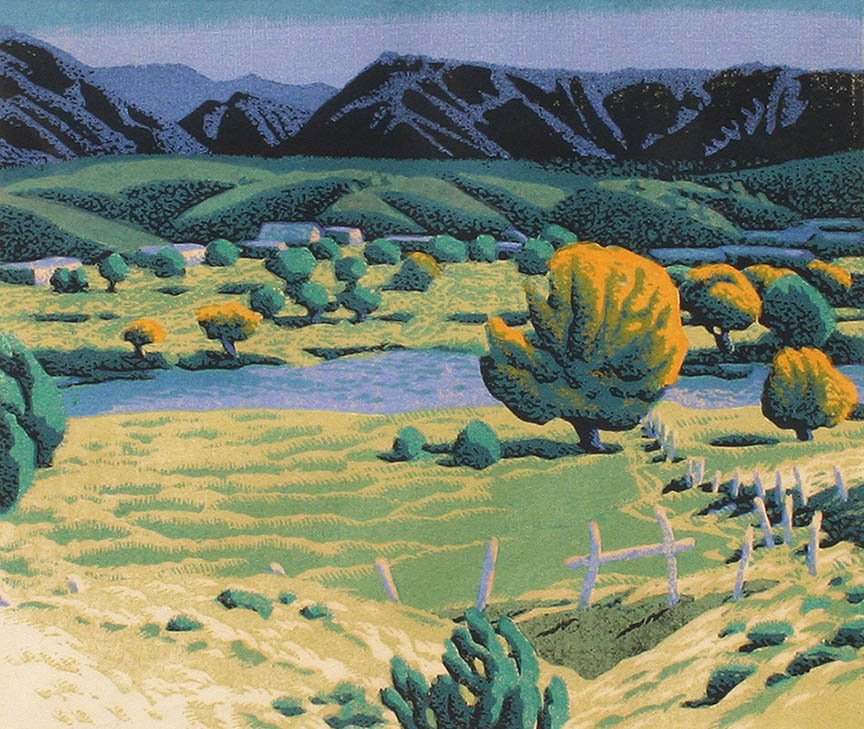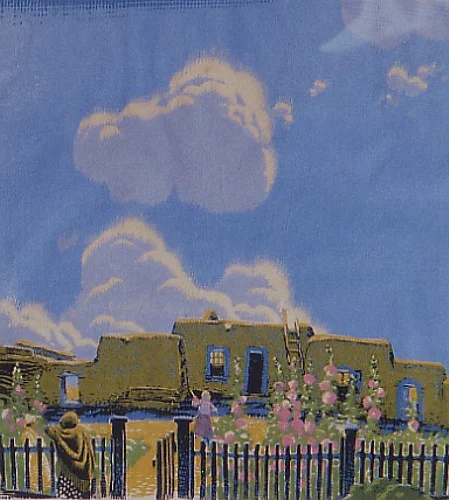Are you interested in selling or consigning your Baumann Woodblock Print?
Click here to contact us now for a free opinion of value
Gustave Baumann
One of America's finest color woodblock artists, Gustave Baumann (1881-1971) didn't jut create art, he brought back an entire medium back to life in the 20th century.
Born in Magdeburg, Germany in 1881, Baumann and his family relocated to the United States when he was a child, eventually settling in Chicago. There, he worked as a commercial engraver while putting himself through night school at the Art Institute of Chicago. In 1904, at age 23, he returned to Germany to study woodblock printing at Munich's the Kunstgewerbeschule ("School of Arts and Crafts"). Upon his return to the U.S., Baumann found that the atmosphere of Indiana’s Brown County nurtured his creativity, and his mastery flourished. He received international acclaim when one of his color woodcuts won the gold medal at the 1915 Pan-Pacific International Exhibition in San Francisco.
After living in or traveling to these cities and states, Baumann visited his friends, artists Walter Ufer and Victor Higgins, in Taos in 1918 and ultimately moved to Santa Fe, New Mexico, where he lived for over 50 years, until his death in 1971. He was perpetually inspired and moved by the area's quiet, secluded, natural beauty, and felt in harmony with nature and the native peoples there.
The general time periods for the locations he worked in and created his color woodcut prints are:
1905 – Munich
1906-1909 – Chicago
1910-1916 – Brown County, Indiana
1917 – New York City, upstate New York, and Provincetown, Massachusetts
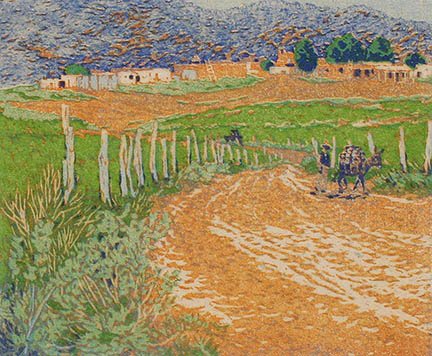
The Loma
SOLD
“The Loma”, (“The Hill” or “The Knoll”) is set in Taos, New Mexico, and was printed in 1919. This woodcut is one of the first prints he executed when he settled in Santa Fe in 1918, and he quickly emerged as a leading artistic figure of the American Southwest.
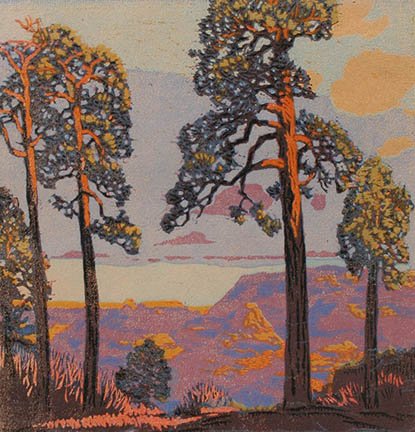
Pines Grand Canyon
SOLD
In 1919 he made his first trip to the Grand Canyon, completing five vividly colored woodblocks upon his return to Santa Fe.
In 1924 he traveled to the Sonoran desert in Arizona, an area that provided a great deal of inspiration, and in 1925 he explored the California Coast. He worked steadily throughout the 1920’s and his work was very popular with collectors who lived in Arts and Crafts style homes.
In the 1930s, he served as area coordinator of the Public Works of Art Project of the Works Progress Administration.
His prints, made from multiple intricately detailed hand-carved woodblocks, are best known for their vivid coloration, striking color contrasts, bright, bold designs, and expert craftsmanship. Many of the works feature his characteristic framing device of tiny dots that serve as a border for the image, and his prints often include the artist's iconic “hand-in-heart” chop which recalls his saying “What you put your hand to, you put your heart behind”.
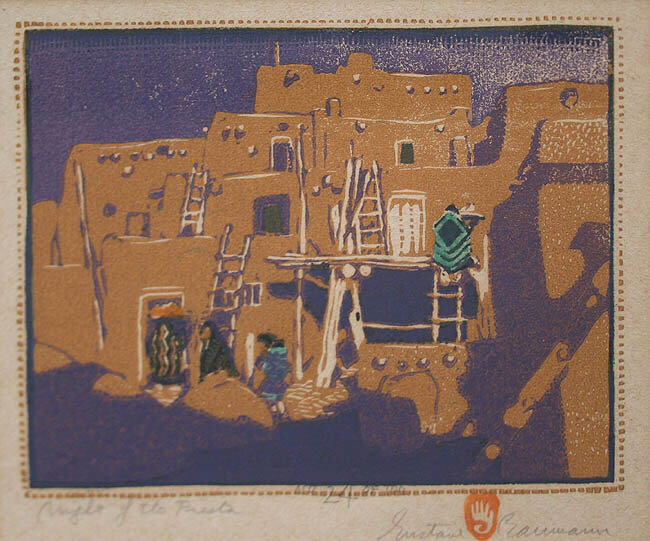
“Night of the Fiesta”
Baumann sometimes printed several different versions/editions of his prints, with changes made to the blocks that alter the composition, and often utilizing different color combinations. Occasionally, the prints in differing editions even have slight variations in the titles. “Night of the Fiesta” above, was printed in two separate editions, the first in 1924, on the left, in a projected edition of 100. Baumann did not always complete the printing of the entire edition, for instance, the highest number found in this edition is numbered 23 of 100. The shadows here are a deep purple, the upper right area features crosshatching, and a solid line forms the interior border. In the second edition, on the right, the sky is now a blue-gray, the adobe is a striking orange-ochre shade, and new green highlights accentuate the blankets and shawl.

“Night of the Fiesta, Taos”
The second edition, above, was printed in a projected edition of 125 and is now titled “Night of the Fiesta, Taos”. The variances in the different editions of his prints were sometimes subtle, and sometimes quite noticeable.

“The Bishop’s Apricot”, left, depicts the apricot tree at Archbishop Jean-Baptiste Lamy's retreat north of Santa Fe in the foothills of the Sangre de Cristo Mountains. The pale coral pink leaves of the tree monopolize the composition, while the darker limbs and branches of the tree contrast sharply against them, and the verdant green grass of the hills heralds the arrival of Spring.

“Harden Hollow”, left, is the name of a valley situated west of Nashville, Indiana, in Brown County, where the artist lived from 1909 to 1917. This edition of “Harden Hollow” was printed in 1935 in five colors from five intricately detailed hand-carved woodblocks on cream Zanders laid paper.
Gustave Baumann’s artworks can be found in the New Mexico Museum of Fine Art (Don’t miss the extraordinary collection of the artist’s hand carved marionettes). And, there is a very extensive collection at the Chicago Institute of Art, Baumann’s alma mater.
For additional information, visit:
New Mexico Museum of Art Exhibition - Gustave Baumann: “the Artist's Environment” July 18, 2025 to February 1, 2026
Wikipedia
Smithsonian American Art Museum
I was shocked when Antiques Roadshow said an old gift from my dad was worth $50k
The Historic Santa Fe Foundation - Gustave Baumann House
“The Mind Behind the Marionettes”
Etched in Wood: The Printmaking of Gustave Baumann
Book: “In a Modern Rendering - Color Woodcuts”
Baumann: “Colorful Cuts” Exhibition at the Cleveland Museum of Art
Go West Said A Small Voice: “Gustave Baumann and Dreams of New Mexico” at the New Mexico Museum of Art
Currently Available Artworks
Sold Artworks
Artist: Gustave Baumann (1881 - 1971)
Size: 9 1/2 x 11 1/4 inches
Medium: Color Woodcut
Artist: Gustave Baumann (1881 - 1971)
Size: 12 3/4 x 12 3/4 inches
Medium: Color Woodcut
Artist: Gustave Baumann (1881 - 1971)
Size: 9 1/2 x 11 1/4 inches
Medium: Color Woodcut
Artist: Gustave Baumann (1881 - 1971)
Size: 12 3/4 x 12 3/4 inches
Medium: Color Woodcut
Artist: Gustave Baumann (1881 - 1971)
Size: 11 x 10 inches
Medium: Color Woodcut
Artist: Gustave Baumann (1881 - 1971)
Size: 10 3/4 x 9 3/4 inches
Medium: Color Woodcut
Artist: Gustave Baumann (1881 - 1971)
Size: 13 x 13 inches
Medium: Color Woodcut
Artist: Gustave Baumann (1881 - 1971)
Size: 9 1/2 x 11 1/4 inches
Medium: Color Woodcut


